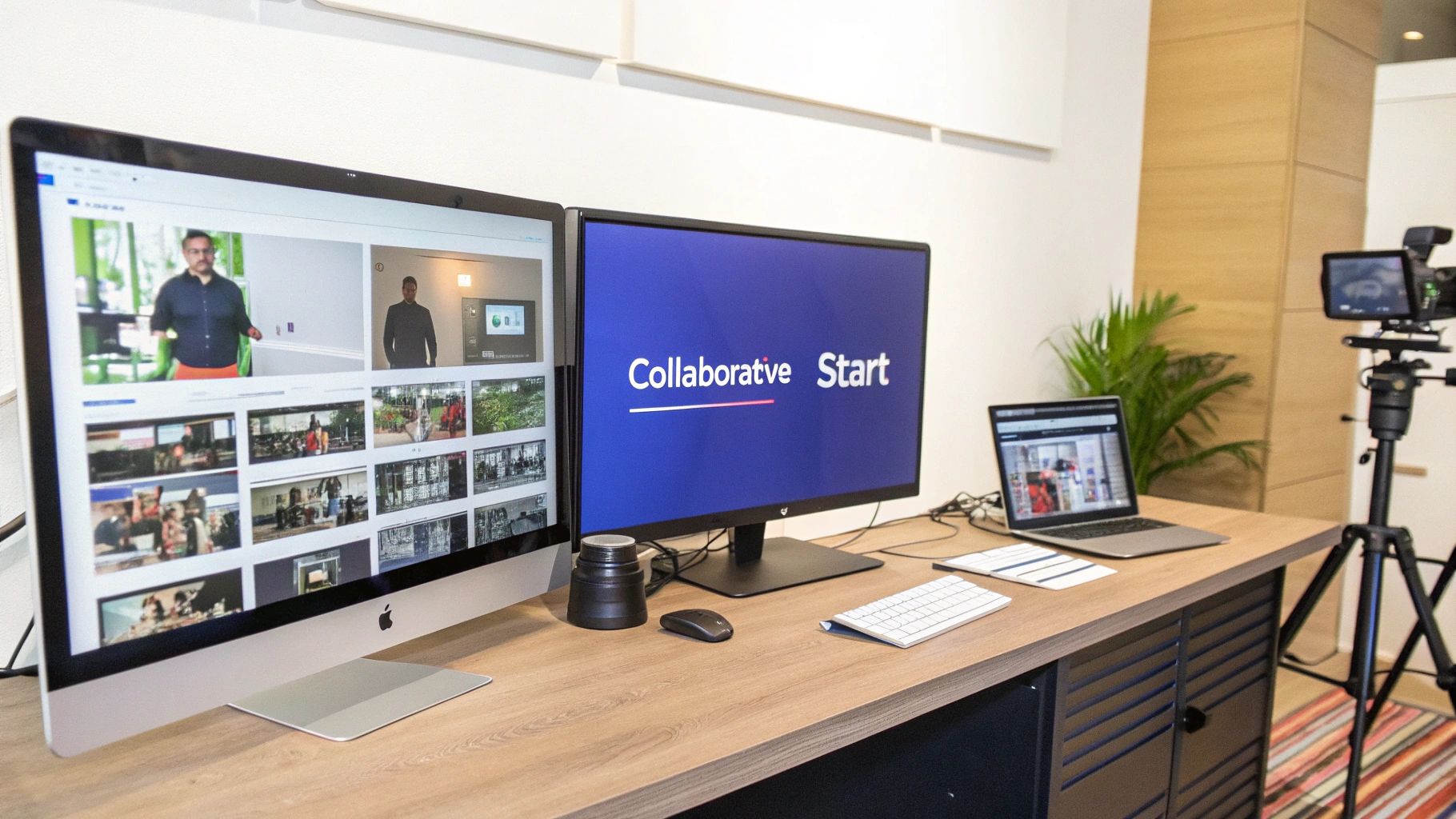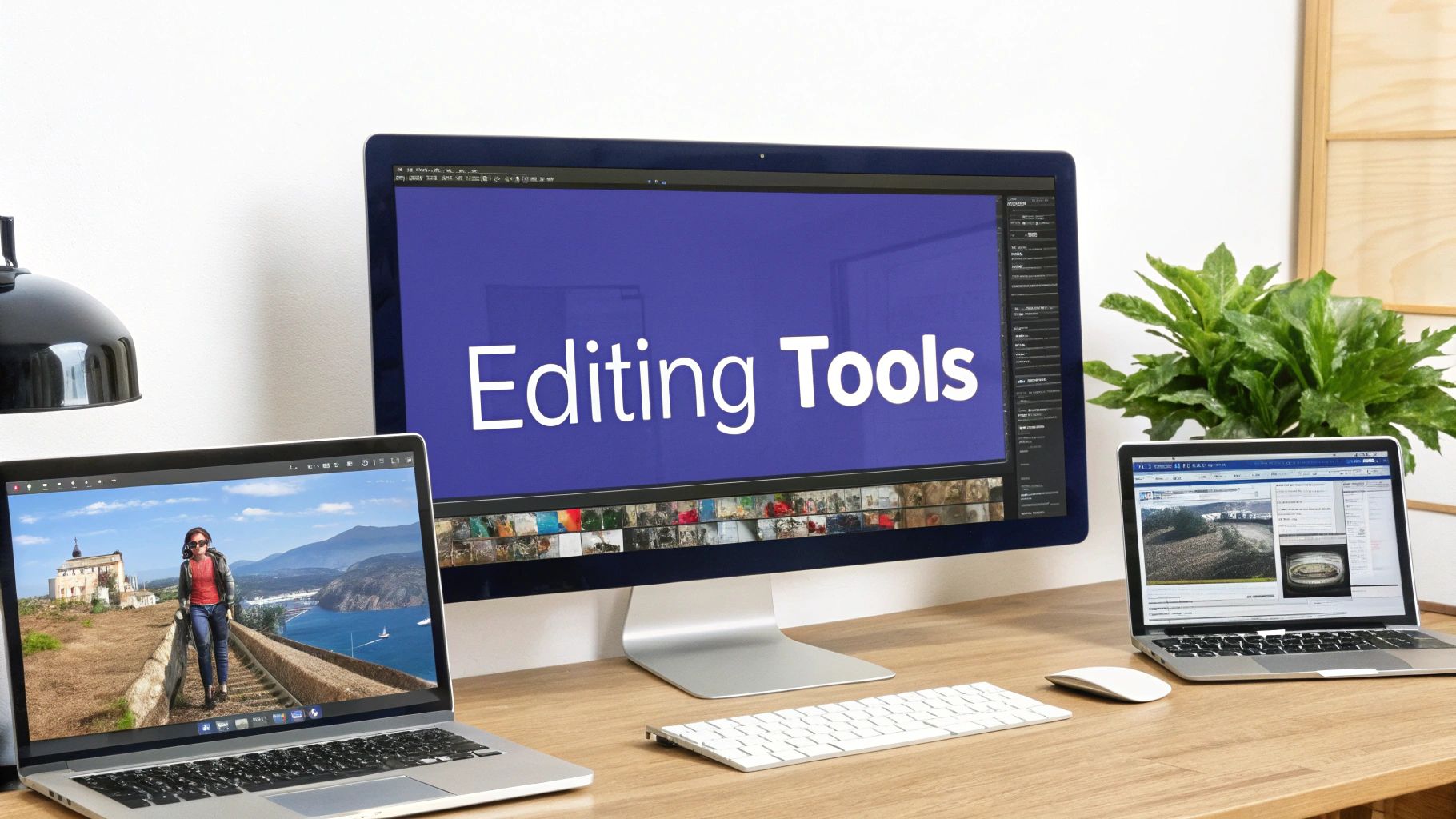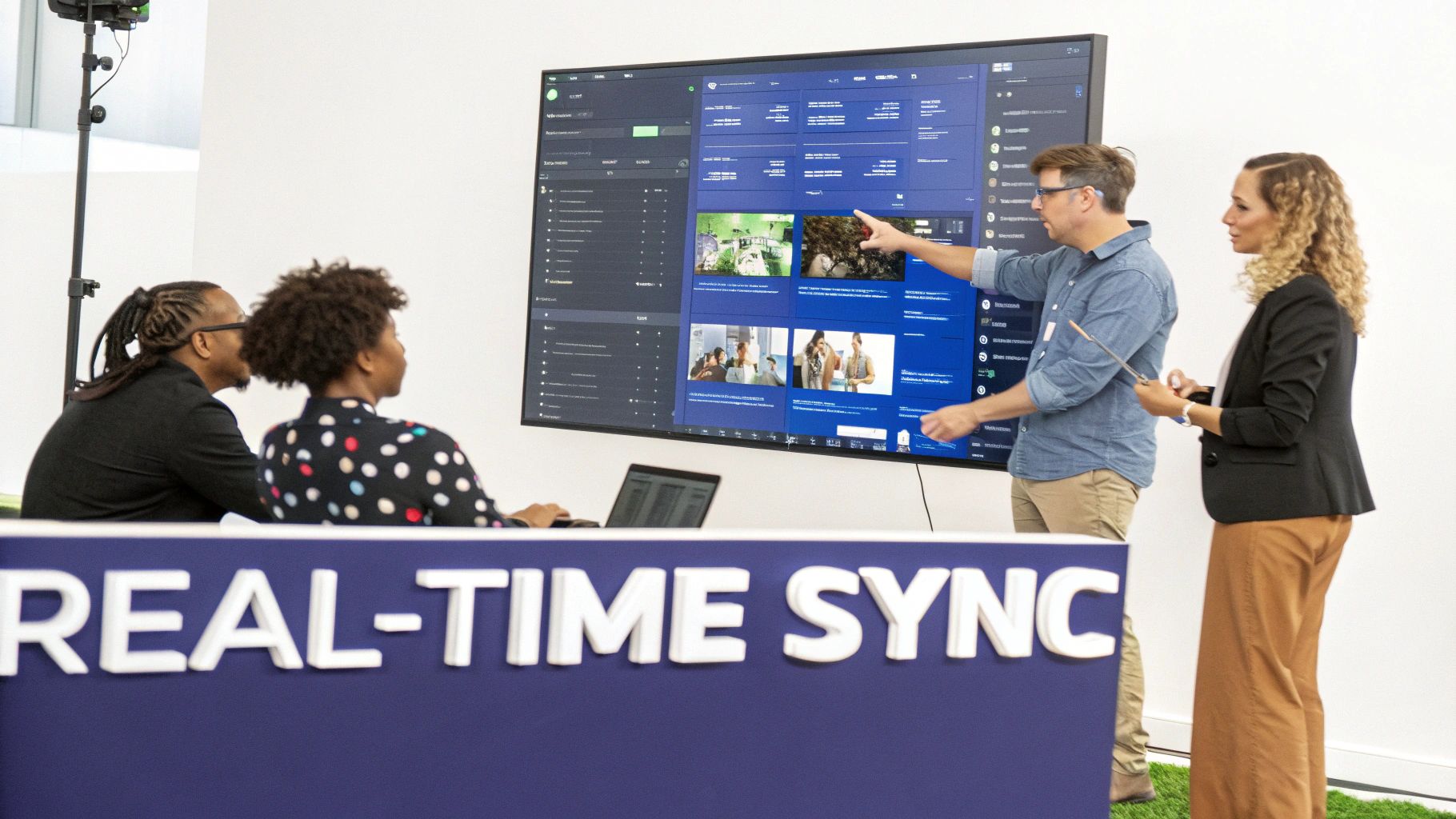The Evolution of Collaborative Video Editing

The world of video editing has dramatically changed. Forget the solitary editor hunched over a workstation. Today, video editing thrives on collaboration, reflecting how modern creative teams work together. This shift changes everything about project approaches, leaving the traditional single-editor workflow behind. The ever-growing demands of video production fuel this evolution.
The Rise of Team-Based Editing
Collaboration empowers teams to utilize diverse perspectives. This means richer storytelling, faster delivery, and truly innovative final products. Different projects have unique needs. A viral social media clip demands a different collaborative strategy than a feature-length documentary. Adapting workflows to specific project types helps teams maximize their strengths and deliver exceptional results.
A fast-paced social media team, for example, might find real-time collaborative video editing software beneficial. This allows simultaneous input on edits and revisions. A documentary team, however, may prefer a platform designed for asynchronous feedback and version control, allowing detailed critiques and revisions over time. The key is finding the right balance between real-time interaction and structured feedback.
Collaborative video editing has significantly evolved alongside technology. One exciting approach is the Tangible Video Editor (TVE). Introduced in a 2007 research paper, this tool uses physical tokens to create a multi-user collaborative environment, drawing inspiration from traditional film editing. In a study with 36 participants, the TVE group reported greater excitement and engagement than a group using traditional software. This underscores how innovative technology can reshape collaborative video editing. Learn more here.
From Linear Workflows to Dynamic Collaboration
The move toward collaborative video editing isn't just about technology; it's a shift in workflow philosophy. Traditional linear workflows, with tasks passed sequentially, can create bottlenecks and stifle creativity. Collaborative video editing promotes parallel workflows, letting multiple team members work simultaneously on different project aspects. This accelerates the editing process and fosters a more dynamic, iterative creative environment.
This approach also builds a stronger sense of shared ownership and responsibility. Working together, editors, producers, clients, and stakeholders develop a deeper understanding of the project’s vision. This shared understanding strengthens communication and creates a more impactful final product reflecting the entire team's input. The evolution of collaborative video editing is an ongoing journey, constantly adapting to the creative industry’s changing demands.
Cutting-Edge Tools That Transform Team Editing

Forget those old-fashioned, linear video editing workflows. Today, collaborative video editing is changing the game, impacting everything from short marketing videos to large-scale film productions. This shift demands that we understand the newest platforms and how they fit into current production processes.
This new way of working is transforming how studios approach team editing. Cloud-native solutions, for example, are quickly gaining popularity, offering benefits like easy access and efficient workflows. At the same time, hybrid approaches are appearing, connecting local and cloud-based editing for greater flexibility.
Cloud-Based Solutions: A New Era of Collaboration
Cloud-based platforms are at the heart of this collaborative video editing revolution. These tools empower multiple users to work on the same project at the same time, regardless of location. This encourages real-time collaboration, accelerating production and boosting creative input. Adobe Premiere Pro, for instance, allows users to collect feedback right on the timeline and share resources with ease.
These platforms simplify the often complex task of managing feedback from different team members, like editors, sound designers, and VFX artists. Real-time collaboration features enhance the quality and speed of video production, making it a vital part of modern video content creation. For a deeper dive into collaborative video editing, check out these helpful tips and tools: Tips and Tools for Effective Collaborative Video Editing. This ultimately leads to more efficient teams, with instant feedback and quicker editing cycles.
Hybrid Approaches: Bridging the Gap
Cloud-only solutions, however, aren't always the best fit. Hybrid approaches blend the advantages of cloud collaboration with the power and precision of local editing. This is especially helpful for projects that need high-bandwidth resources or specialized software. This adaptability allows teams to customize their workflow to the unique requirements of each project. This blended approach ensures teams maintain creative control while still enjoying the benefits of collaborative features. For more on optimizing video review processes, see Streamline Your Workflow With the Best Video Review Software.
Key Considerations for Choosing The Right Tools
Choosing a collaborative video editing platform requires careful consideration of several key factors. Real-time collaboration capabilities, like live editing and chat functions, are a must-have for fast-moving projects. Robust version control is essential for managing different versions and keeping the project stable. Plus, seamless feedback integration makes the review process much smoother, allowing direct annotations and comments within the platform.
Other important practical points to consider are bandwidth requirements, crucial for smooth real-time editing, and security protocols to safeguard sensitive project data. Lastly, compatibility with existing workflows is essential for a smooth transition and maximum team efficiency.
To help you in your decision-making process, take a look at the comparison table below. It summarizes the key features, pricing, and ideal use cases for some of the top collaborative video editing tools available.
Comparison of Collaborative Video Editing Platforms
| Platform | Real-time Collaboration | Cloud Storage | Feedback Tools | Price Range | Best For |
|---|---|---|---|---|---|
| Adobe Premiere Pro | Yes | Yes | Yes | $$$ | Professional video editing |
| DaVinci Resolve | Limited | Limited | Yes | $-$$ | Professional & indie filmmaking |
| Final Cut Pro X | Limited | Limited | Yes | $$ | Mac-based professional editing |
| WeVideo | Yes | Yes | Yes | $-$$ | Education & online content |
| Kapwing | Yes | Yes | Yes | $-$$ | Social media & quick edits |
By carefully evaluating these factors and using the table above as a guide, teams can select the tools that best address their collaborative video editing needs and empower them to produce high-impact content efficiently.
Building Workflows That Actually Work

Tired of disjointed editing processes dragging down your productivity? This section reveals how top production teams structure their collaborative video editing workflows for maximum impact. We'll explore practical strategies for project organization, role definition, and communication protocols that eliminate confusion and boost efficiency.
Structuring Your Collaborative Video Editing Projects
A well-structured project is the bedrock of efficient collaboration. This starts with simple, clear file naming conventions. Think about it: a centralized storage system, accessible to everyone on the team, combined with a detailed project timeline featuring key milestones and deadlines, sets the stage for success.
A consistent naming system for video clips, audio files, and project versions keeps everyone on the same page. This seemingly small detail prevents confusion and makes the entire editing process smoother, saving you valuable time and energy.
Clearly defined roles and responsibilities are also essential. Each team member should know exactly what they're responsible for and how their contributions fit into the bigger picture. This clarity minimizes duplicated effort and missed deadlines, driving your project forward. It also empowers individuals to take ownership, fostering a sense of accountability and pride in their work.
Maintaining Creative Consistency Across Multiple Editors
Maintaining a consistent creative vision can be a challenge when multiple editors are involved. The solution? Establish clear communication protocols and feedback loops from the outset.
Regular team meetings, both online and offline, are invaluable. They create a space for open communication, collaborative decision-making, and problem-solving. This proactive approach keeps everyone aligned and prevents creative drift.
A project style guide is another powerful tool. This document outlines specific editing techniques, color palettes, and audio mixing preferences, ensuring a cohesive look and feel across the entire project. This is especially important for larger projects or those with a strong brand identity. For further insights, explore our guide on Collaborative Feedback Tools for Efficient Team Reviews.
Optimizing Feedback Loops for Remote and Hybrid Teams
Feedback is the lifeblood of collaborative video editing. However, traditional methods like email chains or lengthy review sessions can be cumbersome and stifle creativity. A structured feedback system, using tools like BugSmash, provides clear, actionable feedback directly within the editing platform.
This streamlines the revision process, eliminating confusion and accelerating turnaround times. For remote and hybrid teams, collaborative video editing software with real-time editing and feedback capabilities is a game-changer.
These tools bridge geographical gaps, enabling seamless collaboration. Integrated features like live chat and video conferencing enhance communication and ensure everyone stays synchronized. By implementing these practical strategies, you can build efficient workflows that not only boost productivity but also foster a more collaborative and rewarding editing experience, ultimately leading to superior video content.
The Expanding Market for Team-Based Editing

The rising tide of collaborative video editing is more than a passing trend. It's a powerful shift driven by real market forces demanding team-based solutions. The old way of doing things, with a single editor managing every aspect of a project, is fading fast. This evolution is fueled by several key factors, including rising client expectations and the emergence of powerful new technologies.
Client Demands and Faster Turnaround Times
Today's clients demand faster project completion without compromising quality. This requires video production teams to be incredibly agile and responsive. Collaborative video editing allows multiple team members to work concurrently, dramatically accelerating the entire process.
This approach enables faster revisions and quicker delivery, meeting the demands of today's fast-paced media environment. Clients are also more involved in the creative process than ever before, demanding tools that facilitate real-time feedback and seamless revisions.
The Rise of Cloud-Based and Hybrid Workflows
This need for speed and enhanced collaboration is further amplified by technological advancements. Cloud-based video editing platforms, like BugSmash, allow teams to collaborate from anywhere in the world.
These platforms provide real-time collaborative features, enabling multiple users to work on the same project simultaneously. For projects requiring high-bandwidth resources or specialized software, hybrid workflows combine the power of local editing with the flexibility of the cloud. This adaptability allows teams to tailor their workflow to the specific requirements of each project.
This surge in collaborative editing directly mirrors the broader expansion of the video editing market. The video editing market is projected to reach USD 3.53 billion by 2025, with cloud-based solutions playing a pivotal role. The following table showcases some key growth statistics.
To better understand this exciting growth, let's take a look at the following data. The table below provides a detailed overview of the video editing market's growth trajectory, highlighting the increasing role of cloud-based solutions.
| Year | Market Value | Growth Rate | % Cloud-Based Solutions | Key Growth Drivers |
|---|---|---|---|---|
| 2020 | USD 2.0 billion | – | 30% | Increasing demand for video content |
| 2021 | USD 2.3 billion | 15% | 35% | Rise of social media and online video platforms |
| 2022 | USD 2.7 billion | 17% | 40% | Growing adoption of cloud-based collaboration tools |
| 2023 | USD 3.0 billion | 11% | 45% | Advancements in AI-powered editing features |
| 2024 | USD 3.3 billion | 10% | 50% | Expansion of hybrid workflows |
| 2025 | USD 3.53 billion | 7% | 55% | Increasing demand for faster turnaround times |
As this data reveals, the video editing market is experiencing robust growth, driven by the increasing adoption of cloud-based and collaborative solutions. This trend is expected to continue in the coming years, further solidifying the importance of team-based editing workflows. For a deeper dive into these market trends, explore the detailed analysis available here.
AI-Assisted Editing and the Future of Collaboration
Further propelling this growth is the rise of AI-assisted editing. AI automates time-consuming tasks, empowering editors to focus on the creative heart of their projects. Features like automated transcription, intelligent scene detection, and even AI-powered editing suggestions are increasingly prevalent in collaborative editing platforms.
These innovative tools enhance the efficiency of team-based workflows and allow editors to explore new creative avenues. This means collaborative video editing is not only becoming more accessible, but also more powerful than ever before.
The Impact of Market Competition
The market for collaborative video editing software is buzzing with activity, with new platforms and features constantly emerging. This competition is a powerful catalyst for innovation, leading to more affordable and accessible solutions for teams of all sizes.
The availability of diverse options allows smaller production companies and individual creators to harness the power of team-based editing. This continuous evolution benefits the entire video production ecosystem, pushing the boundaries of collaborative filmmaking.
Collaborative Video Editing Beyond Entertainment
Collaborative video editing is no longer exclusive to Hollywood. It's transforming industries from medical education and scientific visualization to corporate training and social advocacy. These sectors are harnessing the power of teamwork in video editing to overcome challenges and achieve remarkable results.
Collaborative Editing in Medical Education
Medical education depends on visual learning. Collaborative video editing empowers institutions to create engaging and informative content, enriching the learning experience. Teams of medical professionals, instructional designers, and video editors can collaborate to produce high-quality videos. These videos can demonstrate complex surgical procedures, explain intricate anatomical concepts, or showcase best practices in patient care. This collaborative approach ensures accuracy, clarity, and a comprehensive understanding.
Medical schools, for instance, are using collaborative editing platforms to create interactive simulations of medical emergencies. This allows students to practice critical decision-making in a safe environment. This practical application prepares future doctors for real-world scenarios and cultivates essential teamwork skills.
Scientific Visualization Through Shared Video Projects
Scientific research often deals with complex data that can be difficult to understand. Collaborative video editing offers an effective way to visualize this data and communicate findings. Research teams can use video editing platforms to create dynamic animations. These animations can illustrate intricate processes, highlight key trends in data sets, and present scientific discoveries in a visually compelling way. This collaborative environment allows scientists from various disciplines to contribute expertise and ensure accurate and accessible communication. Moreover, collaborative video editing facilitates the creation of engaging presentations for conferences and educational materials for public outreach.
Beyond technological advancements, collaborative video editing’s application extends beyond film. In academia, projects like the 'Dried Fish Matters' initiative demonstrate the process of knowledge co-production. This involves collaborative and social aspects similar to those found in video editing. This project, funded by the Social Sciences and Humanities Research Council of Canada, showcases how multidisciplinary collaboration leads to innovative research outcomes, just as collaborative video editing leads to innovative storytelling. Learn more here.
Collaborative Editing in Corporate Training
Effective corporate training is essential for employee development and organizational success. Collaborative video editing is revolutionizing how companies train their workforce. Training teams can work with video professionals to create interactive training modules, product demonstrations, and employee onboarding videos that are engaging and informative. Platforms like BugSmash facilitate seamless feedback and revisions, ensuring training content is current and aligned with company objectives.
Empowering Social Advocacy Through Inclusive Editing
Social advocacy groups are leveraging collaborative video editing to broaden their reach and amplify their messages. By collaborating on video projects, these groups can share diverse perspectives, create impactful narratives, and build compelling campaigns. Collaborative editing tools democratize storytelling, making it easier to collect testimonials, document community events, and create persuasive videos that advocate for social change. This fosters a sense of shared ownership and empowers communities to tell their stories. Additionally, collaborative editing simplifies adding subtitles and translations, ensuring accessibility for a wider audience.
Overcoming Real-World Collaboration Hurdles
Collaborative video editing holds incredible promise for creative teams. However, it also presents a unique set of challenges. Let's explore these common hurdles, both technical and interpersonal, and discover how to overcome them for smoother, more successful video projects.
Technical Challenges and Solutions
Technical issues can significantly disrupt video editing workflows. Understanding these issues and implementing practical solutions is key to maintaining productivity and project momentum.
Bandwidth Limitations: Slow internet speeds can cause frustrating lag during real-time editing sessions. Optimize your internet connection or consider using proxy files for smoother playback. Scheduling collaborative sessions during off-peak hours can also help alleviate bandwidth congestion.
Storage Management: Large video files quickly consume storage space, leading to organizational headaches and accessibility issues. Implement a structured system with clear file-naming conventions and utilize a centralized cloud storage solution like Dropbox or Google Drive.
Version Control: Losing work due to accidental overwrites is a nightmare. Thankfully, robust version control systems can prevent this. Dedicated tools like BugSmash track changes, allowing easy rollback to previous versions and providing a clear history of project iterations.
Navigating Interpersonal Dynamics
Collaborative video editing not only tests technical prowess but also interpersonal skills. Successfully navigating these dynamics is essential for a positive and productive team environment.
Creative Differences: Disagreements are inevitable in any creative endeavor. Foster a culture of respectful communication and establish clear decision-making processes to resolve conflicts constructively. Focus on shared goals and encourage open dialogue.
Personality Clashes: Strong personalities can sometimes clash, impacting team cohesion. Regularly scheduled team meetings create a dedicated space for open communication and help build consensus. Reinforce the importance of mutual respect and shared project ownership.
Feedback Overload: The sheer volume of feedback during a project can be overwhelming. Implement a structured feedback system. A platform like BugSmash can organize comments, assign tasks, and keep the review process focused and efficient, ensuring every team member feels heard.
Building Team Resilience
Deadlines and pressure are inherent in video production. Equip your team with the tools and strategies to navigate these challenges effectively.
Proactive Communication: Prioritize clear and consistent communication. Establish a clear escalation path for addressing roadblocks and encourage team members to voice concerns early. Proactive problem-solving is crucial for preventing minor issues from escalating into major setbacks.
Preventative Measures: Planning and preparation are your best defense against production pitfalls. Before starting a project, clearly define roles and responsibilities, establish communication protocols, and ensure everyone understands the project's goals.
Shared Vision: Building a successful collaborative video editing team requires more than just technical skill. It requires clear communication, mutual respect, and a shared understanding of the project's vision. By implementing these strategies, teams can overcome challenges, maintain momentum, and achieve creative success.
Ready to optimize your collaborative video editing workflow? Learn more about BugSmash.




